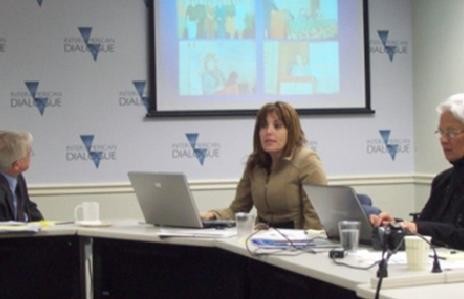
National Conference on Teacher Policy in Costa Rica
Workshop that seeks to promote debate on teacher policy and showcase innovative policies.
Over 100,000 Central Americans enter the United States yearly, the majority of which lack legal status. Violence, family reunification, inequality and poor economic growth are the most prominent drivers of this migration, and many migrants make their journey under very difficult circumstances.
The face of the crisis is changing, however, with increasing numbers of unaccompanied minors leaving Central America and attempting to cross Mexico and enter the United States. From 2013-2014, the number of unaccompanied child migrants apprehended by US authorities along the US-Mexico border increased by 90%.[1]
Source: https://www.cbp.gov/newsroom/stats/southwest-border-unaccompanied-children
FY 2015 saw a relative decrease in the number of unaccompanied Central American children apprehended at the U.S. border, as can be seen in the graphic above. This trend likely reflects stricter enforcement in Mexico, rather than any real decrease in the numbers of Central American children leaving their countries. The number of child migrants “rescued” by Mexican authorities more than doubled from 2013 to 2014, as the chart below indicates.[3]
|
Year and Category |
Foreign minors intercepted by INM |
|
|
2013 |
3,496 |
|
|
2014 |
8,003 |
|
|
2015 to date (Jan – June) |
11,893 |
|
|
|
With family member |
5,780 |
|
|
Without family member |
6,113 |
|
|
0-11 years old |
4,029 |
|
|
12 – 17 years old |
7,864 |
|
|
Male |
8,060 |
|
|
Female |
3,833 |
Source: Boletín INM No. 38/15, June 2015. Available at https://www.inm.gob.mx/index.php/page/Boletin_3815
Whether they are intercepted in Mexico or the United States, the reality is that a large number of unaccompanied children are migrating under dangerous circumstances. Referred to as a “humanitarian crisis” by some leaders, this is a multidimensional phenomenon that has been challenging to understand, much less address.
Migrants themselves can shed light on why this phenomenon is occurring. In surveys, nearly half (47%) of Central American migrants said they know a recent migrant from their country who is a minor. They typically attribute the crisis to a combination of factors, rather than one single cause. Though violence is seen as the most prominent, other factors including poverty, insufficient opportunities at home, and issues with the US immigration system have contributed to the crisis, according to survey responses.
|
Causes Identified |
El Salvador |
Guatemala |
Honduras |
Female |
Male |
|
Violence in Country of Origin |
59% |
38% |
42% |
58% |
44% |
|
Lack of Opportunities in Home Country |
18% |
35% |
29% |
16% |
31% |
|
Family Reunification |
12% |
14% |
16% |
13% |
13% |
Source: Survey of Central American Migrants in the US, the Inter-American Dialogue, July 2014.
Big data can also help shed light on why this phenomenon is occurring. A statistical analysis of 1,000 municipalities in Central America by the Inter-American Dialogue showed that homicide rates were a more powerful driver of international migration than human development indices. In Honduras, nearly 90% of homicides occur in municipalities that all migrants, adults and children, are fleeing.[4] But while child migration and adult migration are occurring for some of the same reasons, there is an even stronger relationship between violence and child emigration than between violence and overall emigration. The towns that child migrants are leaving are among the largest and most violent municipalities in each country.[5]
But regional violence and poor economic development are irrevocably linked. Violence is a byproduct of an environment controlled by underground crime networks, running economies based on extortion, gang violence, intimidation, political harassment, kidnaping, and trafficking. Thus, poverty per se does not induce migration, but a lack of development does. Inadequate economic opportunities are both the cause and the product of violence, and serve to make emigration an attractive option.
As such, solutions to the current problem require applying a humanitarian and human development lens to a longstanding reality of violence in the region and offering strategies for social inclusion, economic modernization, transnational engagement and asset building.
This is part of a series of posts on Central America by the Migration, Remittances and Development Program at the Inter-American Dialogue. An upcoming book by Manuel Orozco and Julia Yansura, Centroamérica en la Mira: La migración en su relación con el desarrollo y oportunidades para el cambio (Editorial Teseo, 2015) offers more in-depth analysis of these issues.
[1] https://www.migrationpolicy.org/programs/us-immigration-policy-program/rising-child-migration-united-states
[2] This includes the approximately 9-month period of October 1, 2014 through June 30, 2015.
[3] Boletín INM No. 38/15, June 2015. Available at https://www.inm.gob.mx/index.php/page/Boletin_3815
[4] Manuel Orozco and Julia Yansura, “Understanding Central American Migration: The Crisis of Central American Child Migrants in Context,” Inter-American Dialogue, August 2014.
[5] The category “minimal or no child migration” indicates that fewer than 100 unaccompanied child migrants were apprehended by US Border Patrol for that municipality during the period January-May 2014. This data comes from a map by the Department of Homeland Security showing the number of apprehended unaccompanied child migrants coming from specific hometowns in Central America. A copy of the map is available at https://adamisacson.com/files/dhsuacmap.pdf
Workshop that seeks to promote debate on teacher policy and showcase innovative policies.
PREAL reviews broad spectrum of its activities and discusses priorities for improving education policy in the coming year.
Progress of Latin American countries and the Caribbean towards the six Education for All goals.
